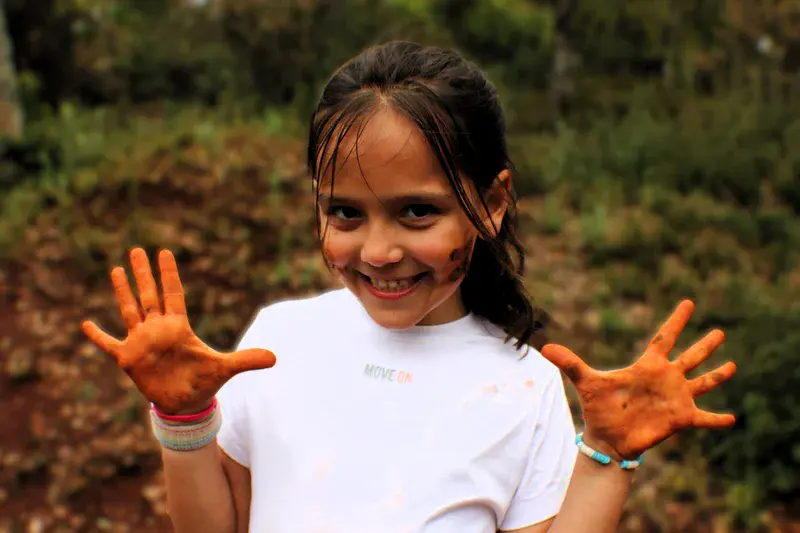
A mini-experiment by a mini-scientist
by Antonio Jordán, University of Seville, Sevilla, Spain
First in English:
Valentina Aguilar-Dié is a mini-scientist who experiences every trip to the countryside as a little adventure. She is fascinated by rocks, plants, fungi, and insects… and today, without realizing it, she conducted a small geochemical experiment.
The soil she played with is rich in red clays, particularly those containing high concentrations of iron oxides like hematite (Fe₂O₃). This deep red color is typical of well-oxidized, well-drained soils, where iron is present in its most stable and least soluble form. However, when clays become moistened -whether with water from a pond, a stream, or even early morning dew- they can release small amounts of iron in soluble ionic forms (Fe²⁺ and Fe³⁺), especially if the water is slightly acidic (low pH) or contains dissolved CO₂, which forms carbonic acid.
Once exposed to air, these iron ions oxidize quickly. Fe²⁺ (ferrous) is converted into Fe³⁺ (ferric), which then hydrolyzes to form hydrated iron oxides like goethite (FeO(OH)) or ferrihydrite. These compounds give the water a characteristic reddish tint and exist as colloidal particles (less than 1 µm in size), capable of remaining suspended in the water like a natural pigment.
When Valentina wet her face and hands, these colloidal particles remained suspended in the thin layer of water that ran over her skin. The surface of human skin, with its microtextures and slight surface charge, facilitates the adhesion of both clay particles and iron oxides through physical forces (like Van der Waals interactions) and electrostatic attraction. That’s why, even after some time has passed, her cheeks and hands still bear a reddish tint - a fleeting but telling trace of the complex physical and chemical processes constantly shaping the soil.
Ahora, en español:
Valentina Aguilar Dié es una minicientífica que disfruta cada excursión al campo como una pequeña aventura. Le fascinan las piedras, las plantas, los hongos y los insectos… y hoy, sin saberlo, también ha hecho un pequeño experimento de geoquímica.
El suelo con el que ha estado jugando es rico en arcillas rojas, especialmente en formas con alto contenido de óxidos de hierro como la hematita (Fe₂O₃). Esta coloración rojiza tan intensa es típica de suelos bien oxidados y bien drenados, donde el hierro se encuentra en su forma más estable y menos soluble. Sin embargo, cuando las arcillas se humedecen -como ocurre al mojarse las manos y la cara con agua de un charco, un arroyo o incluso del rocío- pueden liberar pequeñas cantidades de hierro en forma de iones solubles (Fe²⁺ y Fe³⁺), especialmente si el agua tiene algo de acidez (pH bajo) o contiene CO₂ disuelto, lo que forma ácido carbónico.
Una vez en contacto con el oxígeno del aire, estos iones de hierro se oxidan rápidamente. El Fe²⁺ (ion ferroso) se convierte en Fe³⁺ (ion férrico), y este, al hidratarse, forma minerales como la goethita (FeO(OH)) o la ferrihidrita, que tiñen el agua de un color rojizo. Estas formas hidratadas y amorfas del óxido de hierro son muy finas, de tamaño coloidal (menor a 1 µm), y pueden mantenerse en suspensión en el agua, como un tinte natural.
Cuando Valentina se mojó las manos y la cara, estas partículas coloidales que estaban suspendidas en el agua se le quedaron en la piel. La superficie cutánea, ligeramente cargada y con microtexturas, favorece la adhesión de las partículas de arcilla y de los óxidos de hierro mediante fuerzas físicas (como las fuerzas de Van der Waals) y enlaces electrostáticos. Por eso, aunque haya pasado un rato desde que jugó con el barro, sus mejillas y sus manos siguen teñidas de rojo: una marca efímera, pero muy reveladora, de los procesos físico-químicos que operan constantemente en el suelo.
Categories
Location
- Europe (3893)
- Southern Europe (1691)
- Spain (819)
- Exact location (-5.6140 W, 37.9520 N)
Tags
- terra rossa (18)
- colour (6)
- iron oxide (4)
- color (24)
- redox (7)
- clay (20)
- iron hydroxides (3)
- red (7)
- geochemistry (14)
- iron oxides (3)
Colours
Image properties
6000 × 4000 px;
image/jpeg; 1.7 MB
Camera:
Canon EOS 2000D
Taken on 18
April
2025
Submitted on 7 May 2025
Licence
Creative Commons Attribution-ShareAlike 3.0 Unported (CC BY-SA 3.0)
Credit
Antonio Jordán (distributed via imaggeo.egu.eu)
Share
Appreciate
Report